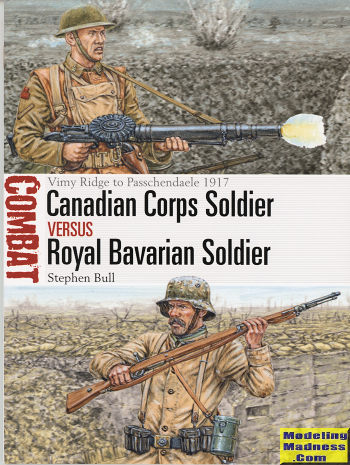Osprey's Candian Corps Soldier vs Royal
Bavarian Soldier
|
Author: |
Stephen Bull |
|
Publisher |
Osprey |
|
Price |
$20.00 MSRP |
|
Reviewer: |
Scott Van Aken
|
|
Notes: |
80 pages, 7¼ x 9¼
inches, softbound
ISBN: 978-1-4728-1976-5 |
 Osprey's
Combat series is one that is particularly well thought out. It compares two
different sides of a conflict. Often, as in this case, they are adversaries who
faced each other in battle. It should come as no surprise to most that all
soldiers are not trained the same. Their officers have learned different ways of
handling similar situations and the tactics they use are often quite different.
Osprey's
Combat series is one that is particularly well thought out. It compares two
different sides of a conflict. Often, as in this case, they are adversaries who
faced each other in battle. It should come as no surprise to most that all
soldiers are not trained the same. Their officers have learned different ways of
handling similar situations and the tactics they use are often quite different.
A case in point are the two examples provided in this volume. During
WWI, there was a considerable amount of regional cohesion in units of all sizes.
For instance, the Canadians were gathered together from different areas of the
country where they had trained with comrades from the same part of the nation or
even the same city. In Germany, many soldiers yet considered themselves 'German'
and were Bavarians or Prussians. A similar mind-set existed for the Canadians,
though perhaps not on quite the same level.
For much of WWI, Germany fought a defensive war once the trench lines
were established. As the war changed, so did the way they operated their
defenses. Initially, like the British, French and others, they massed most of
their troops in the first line of trenches, but losses following heavy
bombardment taught them to only lightly man the forward trenches and to provide
additional trench lines father back. It was in the farthest trenches, outside
the range of most enemy guns that these troops spent much of their time.
There was no lack of bravery on either side, but the Germans simply did
not have the manpower to put into play as did the Entente, so they fought the
war differently.
In this book, the author covers the beginnings of both groups of
soldiers and how their differences in combat tactics affected the outcome. It
concentrates on the last two years of the war and provides examples where both
sides were able to gain success, though inevitably it was the German side who
had to call it quits, and not because of failure on the front lines, but other
aspects of the war that made things untenable.
Chock full of great photos, some excellent illustrations, a few nicely
done tables and descriptions of three major battles, this book
concisely demonstrates how the two sides fared against each other. It is a book
that is both fascinating to read and provides a look at the two antagonists that
I know you will find interesting. A superb read and highly recommended.
August 2017
Copyright ModelingMadness.com. All rights
reserved.
Thanks to Osprey Publishing for the review book. For more on the complete line of Osprey books,
visit www.ospreypublishing.com
.
If you would like your product reviewed fairly and fairly quickly, please
contact
the editor or see other details in the Note to
Contributors.
 Osprey's
Combat series is one that is particularly well thought out. It compares two
different sides of a conflict. Often, as in this case, they are adversaries who
faced each other in battle. It should come as no surprise to most that all
soldiers are not trained the same. Their officers have learned different ways of
handling similar situations and the tactics they use are often quite different.
Osprey's
Combat series is one that is particularly well thought out. It compares two
different sides of a conflict. Often, as in this case, they are adversaries who
faced each other in battle. It should come as no surprise to most that all
soldiers are not trained the same. Their officers have learned different ways of
handling similar situations and the tactics they use are often quite different.